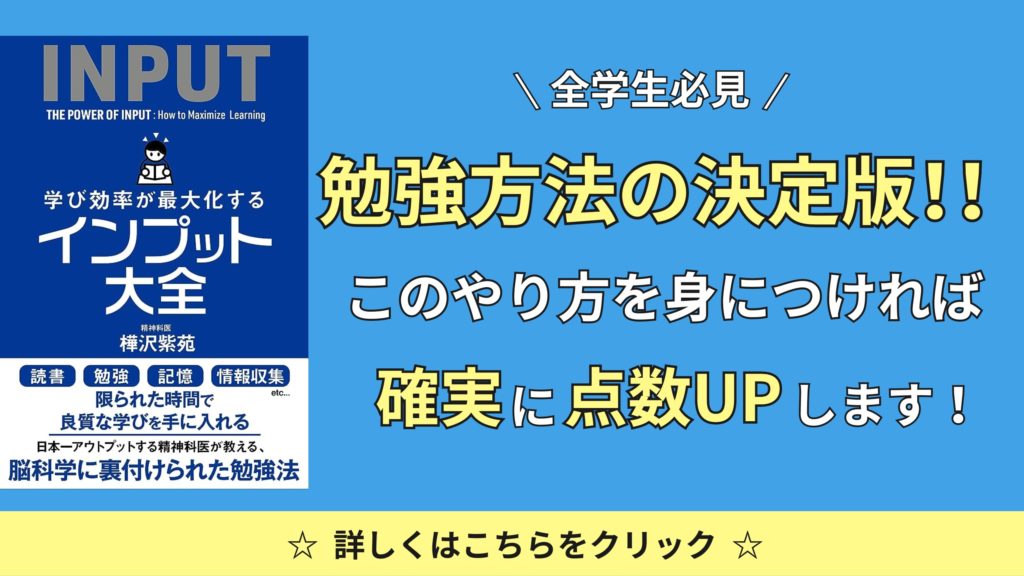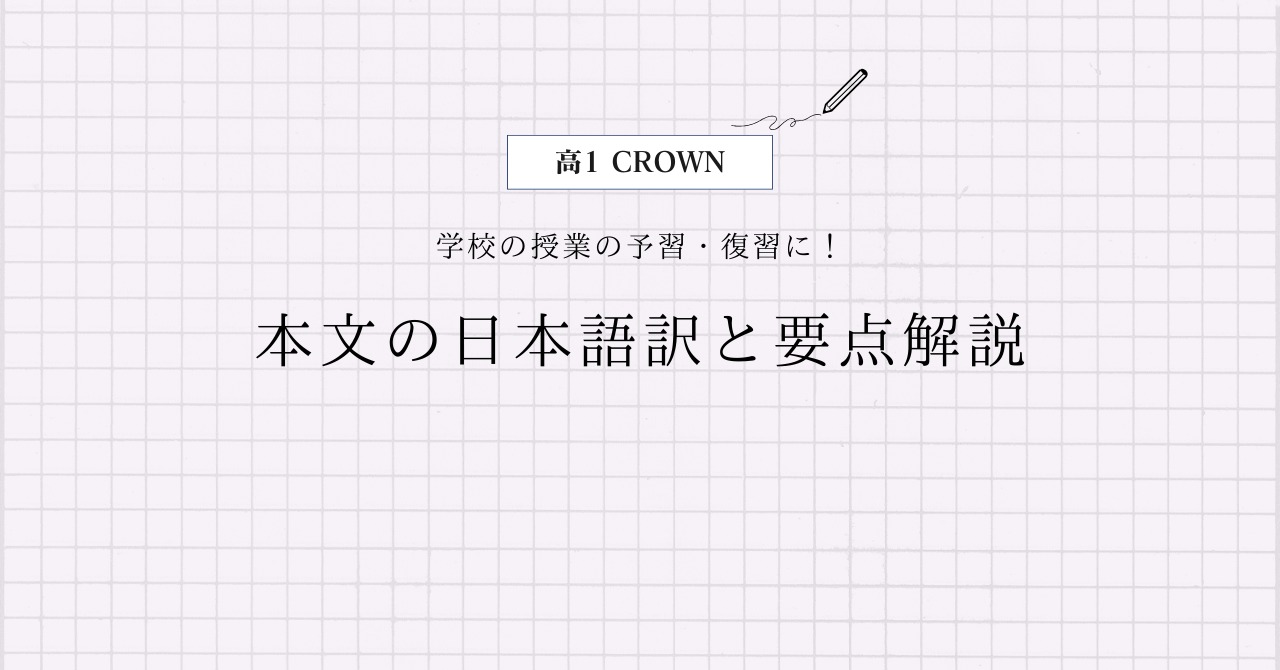三省堂 高1CROWN English Communication1 Lesson6 Section1の本文の日本語訳と重要箇所の解説です。
Section6-2, 6-3, 6-4の解説はこちらからご覧ください。
>高1CROWN English Communication1 Lesson6 Section2 本文和訳
>高1CROWN English Communication1 Lesson6 Section3 本文和訳
>高1CROWN English Communication1 Lesson6 Section4 本文和訳
- CROWN English Communication1 Lesson6 Section1 本文と日本語訳
- CROWN English Communication1 Lesson6 Section1 重要事項の解説
- You and Your Smartphone ― Who’s in Charge?
- Smartphones are changing our lives ― but not always for the better.
- There are dangers of misuse.
- It’s about time to examine carefully whether we are using smartphones in a healthy way.
- Everywhere we look, we see people bending over their smartphones.
- They are in their own private world.
- This kind of scene has become so common that we no longer find it strange.
- It is estimated that more than four billion people in the world are using smartphones.
- In Japan, the number of people who own smartphones has been increasing rapidly.
- In 2011, only 14.6% of the total population was using smartphones.
- By 2018, the rate had increased to 64.7%.
- On average, Japanese teenagers spend 143 minutes a day using smartphones just for the Internet, while people in their 20s spend 129 minutes for the same purpose.
- These figures indicate that we are now living in a new culture where the digital world meets the real world.
- CROWN English Communication1 Lesson6 Section1 まとめ
CROWN English Communication1 Lesson6 Section1 本文と日本語訳
You and Your Smartphone ― Who’s in Charge?
「あなたとスマートフォン―だれに責任があるのか?」
Smartphones are changing our lives ― but not always for the better.
「スマートフォンは私たちの生活を変えていますが,必ずしもより良いものに変えているわけではありません。」
There are dangers of misuse.
「乱用の危険性があります。」
It’s about time to examine carefully whether we are using smartphones in a healthy way.
「そろそろ私たちは正しい方法でスマートフォンを使っているかどうか,注意深く調べてもいいでしょう。」
Everywhere we look, we see people bending over their smartphones.
「どこを見ても,私たちは人々がスマートフォンに向かって前かがみになっているのを目にします。」
They are in their own private world.
「彼らは自分だけの世界に入っています。」
This kind of scene has become so common that we no longer find it strange.
「こういった光景はとても一般的になってきているので,もはや変だとは思いません。」
It is estimated that more than four billion people in the world are using smartphones.
「世界の40億人以上がスマートフォンを使っていると推定されています。」
In Japan, the number of people who own smartphones has been increasing rapidly.
「日本では,スマートフォンを所有している人の数が急激に増え続けています。」
In 2011, only 14.6% of the total population was using smartphones.
「2011年は,全人口の14.6%しかスマートフォンを使っていませんでした。」
By 2018, the rate had increased to 64.7%.
「2018年までに,その割合は64.7%まで増加しました。」
On average, Japanese teenagers spend 143 minutes a day using smartphones just for the Internet, while people in their 20s spend 129 minutes for the same purpose.
「平均して,日本の10代の若者は,1日に143分をインターネット利用のためだけのスマートフォンの使用に使っていて,一方で20代の人々は同じ目的で129分を使います。」
These figures indicate that we are now living in a new culture where the digital world meets the real world.
「これらの数字は,デジタルの世界が現実世界を満たす新しい文化の中で私たちは生きている,ということを示しています。」

CROWN English Communication1 Lesson6 Section1 重要事項の解説
You and Your Smartphone ― Who’s in Charge?
「―」は「ダッシュ」といって,直前の語句を補足する働きがあります。「:(コロン)」や「;(セミコロン)」より少しくだけた印象になります。
“in charge”は「責任を負って,担当して」といった重要表現です。
直訳すると「誰が責任者ですか?」といった感じですね。
Smartphones are changing our lives ― but not always for the better.
ここでは「現在進行形」が使われています。
“change A for B”で「AをBに変える」という意味です。少し離れていますが,Aが“our lives”で,Bが“the better”ということですね。
“lives“は“life(生活,人生)“の複数形で,語尾が”f,fe”で終わる名詞を複数形にするときは”f,fe”を取って”ves”をつけます。
knife→knives(ナイフ), leaf→leaves(葉)などがあります。
「―」以下は,“not always~”という「部分否定」になっていて,「必ずしも~というわけではない」と訳します。
“better”は“good”の「比較級」ですね。
また,ここは直前の文の内容が省略されていて,正確には“― but smartphones are not always changing our lives for the better lives.”となりますよ。
There are dangers of misuse.
ここでは「there構文」が使われていますね。
“danger”は「危険(性)」,“misuse”は「乱用,悪用」という名詞です。
It’s about time to examine carefully whether we are using smartphones in a healthy way.
“It’s about time to 動詞の原形”は「そろそろ~してもよい頃だ」という重要表現です。
“examine”は「を調べる,調査する」という動詞,“carefully”は「注意深く」という副詞になります。
“whether”は「~かどうか」という重要な接続詞で,後ろには「現在進行形」が続いていますね。
“healthy”は「健康的な,正しい」といった形容詞で,“way”は「方法,道」という名詞です。
Everywhere we look, we see people bending over their smartphones.
“everywhere”は「どこでも」という副詞ですが,今回のように“everywhere 主語 動詞”という形で,「どこを~しても」という意味の接続詞として使うこともできます。
“see”は「知覚動詞」で,“知覚動詞 名詞 動詞の原形/進行形”で,「名詞が~する/しているのを…する」となります。
“bend over~”は「~に向かって前かがみになる,かがむ」といった意味です。
They are in their own private world.
“They”は“people”を指しています。
“own”は「自身の」,“private”は「個人用の,1人だけの」という形容詞で,合わせて「自分だけの」としました。
This kind of scene has become so common that we no longer find it strange.
“kind of~”は「~の種類」という重要表現ですが,今回の“This kind of”は「こういった」と簡単に訳しました。“scene”は「光景,景色」という名詞です。
“become”は「~になる」という動詞の過去分詞形で,ここでは「現在完了」になっていますね。
“common”は「一般的な,普通の」,“strange”は「変な,奇妙な」という形容詞で,“no longer~”は「もはや~ではない」という重要表現です。
“find 名詞 形容詞”も「名詞が~だと思う,分かる」という重要表現になります。
また,ここでは「so that構文」も使われていて,「とても~なのでthat以下…」という風に訳します。
It is estimated that more than four billion people in the world are using smartphones.
“estimated”の後ろには「接続詞that」がありますね。
“It”は形式主語で,”that”以下が真の主語となります。
“estimate”は「を推定する,見積もる」という動詞で,ここでは「受動態」になっています。
“more than~”は「~より多くの」という意味です。“over”も同じ意味があります。
ただし,人口や年月など元の数が大きい場合,つまりその数を含んでいるかが問題でない場合は「~以上」と訳してもOKです。
“billion”は「10億(の)」という意味ですね。
In Japan, the number of people who own smartphones has been increasing rapidly.
“the number of~”は「~の数」という重要表現になります。
また,“who”は「主格の関係代名詞」で,“who own smartphones”が先行詞“people”を修飾していますね。
この“own”は動詞で「を所有する」という意味となり,後ろは「現在完了進行形」になっていますね。
“increase”は「増加する」という動詞で,“rapidly”は「急速に」という副詞です。
In 2011, only 14.6% of the total population was using smartphones.
ここでは「過去進行形」が使われています。
“only”は「~だけ,たった~しか」という副詞ですね。
“of”は前置詞で,”A of B”の形で「BのA」というように後ろから前に訳します。
“total”は「全体の」という形容詞で,“population”は「人口」という名詞になります。
By 2018, the rate had increased to 64.7%.
“by”は「~までに」という期限を表す前置詞です。他にも色々な意味があるので,以下に簡単にまとめておきます。
1.受動態とセットで「~によって」
2.”by+乗り物”で「交通手段」
3.「~までに」という期限
4.「~のそばに」という場所を表す
“rate”は「割合」という名詞で,後ろは「過去完了の継続用法」になっていますね。
On average, Japanese teenagers spend 143 minutes a day using smartphones just for the Internet, while people in their 20s spend 129 minutes for the same purpose.
“on average”は「平均して」という表現です。
“teenager”は「10代の若者」という名詞,“spent”は“spend(を過ごす,費やす)”の過去形で,“spend 時間 動詞のing形”で「~するのに時間を費やす」という重要表現になります。
“時間 a 期間”という形で,「1回の期間に~分/時間」といった意味になります。今回は“a day”なので「1日に」ですね。
“just”は「ただ,~だけ」という副詞です。
“while”は「一方で」という重要な接続詞で,“in one’s 20s”は「20代で・の」という意味になります。
“same”は「同じ」という形容詞で,“purpose”は「目的」という名詞ですね。
These figures indicate that we are now living in a new culture where the digital world meets the real world.
“these”は“this”の複数形で,「これらは(の)」といった意味になります。
“figure”は「数字,形,図」,“culture”は「文化」という名詞で,“indicate”は「を示す,指摘する」という動詞です。後ろには「接続詞that」がありますね。
“where”は「関係副詞」で,”where the digital world meets the real world”が先行詞“a new culture”を修飾しています。
元々は“We are now living in a new culture.”と“The digital world meets the real world there.”という2文ということですね。
“digital”は「デジタルの,数字の」,“real”は「現実の,本当の」という形容詞で,“meet”は「を満たす」という動詞です。「会う」以外にも意味があるので覚えておきましょう!

CROWN English Communication1 Lesson6 Section1 まとめ
以上がCROWN English Communication1 Lesson6 Section1の日本語訳となります。
「知覚動詞」「関係副詞」などの使い方をしっかり確認しておきましょう!
>高1CROWN English Communication1 Lesson6 Section2 本文和訳
>高1CROWN English Communication1 Lesson6 Section3 本文和訳
>高1CROWN English Communication1 Lesson6 Section4 本文和訳
何か分からない点や他に解説してほしい点があれば,お気軽にコメントしてください!




コメント